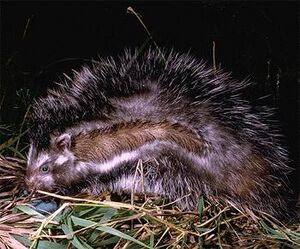Maned rat facts for kids
Quick facts for kids African crested ratTemporal range: Early Pleistocene - Recent
|
|
|---|---|
 |
|
| Conservation status | |
| Scientific classification | |
| Genus: |
Lophiomys
|
| Species: |
imhausi
|
The maned rat or African crested rat (Lophiomys imhausi) is a unique rodent found in East Africa. It is active at night (which means it's nocturnal) and has long hair and a bushy tail. It looks a bit like a porcupine. What makes this rat super special is that it's the only known poisonous rodent in the world! It gets its poison from plants to protect itself from animals that might try to eat it.
Contents
Description
The maned rat's body can grow up to 14 inches (35 cm) long. If you measure from its head to the tip of its tail, it can be about 21 inches (53 cm) long. Its fur is mostly silver and black, with a soft, woolly grey and white layer underneath. Its face and legs have short, black fur.
The Special Mane
A long, stiff mane of black and white hair runs from the top of its head all the way to its tail. This mane has a special strip of skin underneath it. When the rat feels scared or excited, it can make its mane stand up. This opens up the strip of skin, showing a special area.
The hairs in this area are very absorbent, like a sponge. The rat chews on the bark of a plant called the Acokanthera schimperi, also known as the poison arrow tree. Then, it deliberately smears the poison from this plant onto its special mane hairs. This creates a powerful defense! If a predator tries to bite the rat, it gets a mouthful of poison. This can make the predator very sick or even kill it. The maned rat is the only rodent known to use and store poisons from other species to protect itself. It doesn't seem to get sick from the poison itself.
Diet
In the wild, maned rats mostly eat leaves, fruit, and other parts of plants. But if they are kept in captivity, they have been seen eating meat, grains, root vegetables, and even insects.
How They Eat
When a maned rat eats, it sits up on its back legs. It uses its front paws to hold the food and bring it to its mouth. This rat has a very unique stomach for a rodent. It has five different sections, which helps it digest its food. This special stomach allows it to break down tough plant materials like cellulose, getting more energy from its plant-based diet.
Habitat
Maned rats live in various places, from areas near the sea in Ethiopia and Somalia, to drier, higher forests and woodlands. You can find them in Somalia, Ethiopia, Sudan, Tanzania, Uganda, and Kenya. Scientists have even found old bones of maned rats as far north as Israel, showing they once lived there too.
They often live in rocky areas or inside hollow tree trunks. They also make their homes in holes along the tops of ravines or among rocks on cliff-faces.
Reproduction and Family Life
For a long time, people thought maned rats lived alone. But now we know they can be quite social! Scientists have found several rats living in the same area. They even make purring sounds and groom each other, which means they might live in family groups with a male, a female, and their babies.
Baby Rats
A mother maned rat usually has 1 to 3 babies at a time. When they are born, the babies have a little bit of hair. Their white markings and black stripes can be seen clearly after about 9 days. By day 13, their eyes open. Their hair grows long enough for their special crest (mane) to stand up by day 20. The young rats start moving around by day 23 and are ready to stop drinking their mother's milk by day 40.


